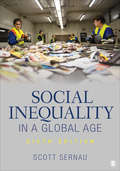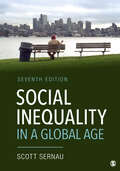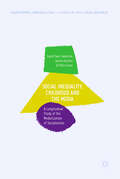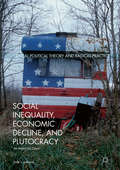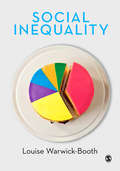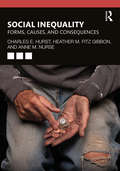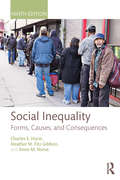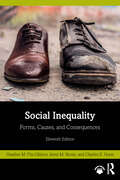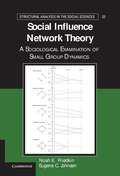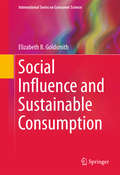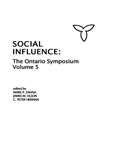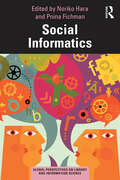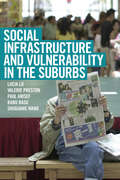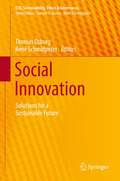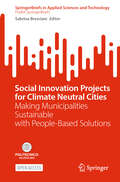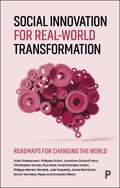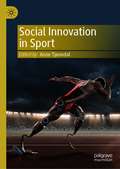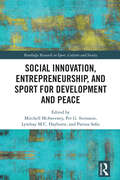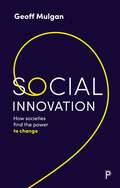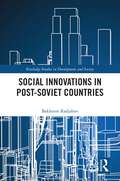- Table View
- List View
Social Inequality in a Global Age
by Scott R. SernauSocial Inequality in a Global Age examines systems of inequality in the U.S. based on race, class, gender and sexuality, as well as the dynamics of power and privilege. While the focus is on U.S., the the book discusses the interplay of systems of inequality in the U.S, and the changing global economy.
Social Inequality in a Global Age
by Scott R. SernauSocial Inequality in a Global Age examines systems of inequality in the U.S. based on race, class, gender and sexuality, as well as the dynamics of power and privilege. While the focus is on U.S., the the book discusses the interplay of systems of inequality in the U.S, and the changing global economy.
Social Inequality in a Global Age
by Scott R. SernauSocial Inequality in a Global Age provides a sociological framework for analyzing inequality within the United States in the context of global stratification and a rapidly changing world economy. With insightful analysis, and using examples drawn straight from today′s headlines, Scott Sernau explores the multiple dimensions of inequality—class privilege, race and ethnicity, gender and sexuality, status and power—and how they intersect with each other. As it explores each dimension of inequality, the text analyzes the relationship between changing global power structures and growing inequalities within societies. Throughout, a focus on social action and community engagement encourages students to become involved, active learners in the classroom and engaged citizens in their communities.
Social Inequality in a Global Age
by Scott R. SernauSocial Inequality in a Global Age provides a sociological framework for analyzing inequality within the United States in the context of global stratification and a rapidly changing world economy. With insightful analysis, and using examples drawn straight from today′s headlines, Scott Sernau explores the multiple dimensions of inequality—class privilege, race and ethnicity, gender and sexuality, status and power—and how they intersect with each other. As it explores each dimension of inequality, the text analyzes the relationship between changing global power structures and growing inequalities within societies. Throughout, a focus on social action and community engagement encourages students to become involved, active learners in the classroom and engaged citizens in their communities.
Social Inequality, Childhood and the Media: A Longitudinal Study of the Mediatization of Socialisation (Transforming Communications – Studies in Cross-Media Research)
by Ingrid Paus-Hasebrink Jasmin Kulterer Philip SinnerThis open access book presents a qualitative longitudinal panel-study on child and adolescent socialisation in socially disadvantaged families. The study traces how children and their parents make sense of media within the context of their everyday life over twelve years (from 2005 to 2017) and provides a unique perspective on the role of different socialisation contexts, drawing on rich data from a broad range of qualitative methods. Using a theoretical framework and methodological approach that can be applied transnationally, it sheds light on the complex interplay of factors which shape children’s socialisation and media usage in multiple ways.
Social Inequality, Economic Decline, and Plutocracy
by Dale L. JohnsonThis book aims to further an understanding of present day America by exploring counter-hegemony to the rule of capital and offering guidelines for strategizing change proceeding from the dialectic of What Is and What Ought to Be. The author analyzes neoliberal global order and its political expressions through discussions of the dominance of finance capital in the late twentieth century, the triumph of ideology, the closing of avenues to reform, the problem of the captive state, and a sociological analysis of rule by "divide and conquer. " The book concludes with a look at the history of movement politics in culture, arts, economics, and politics. It resounds with a hope that challenges to hegemony can use many paths to change, of which the electoral path is but one of many fronts, in the long-term struggle for radical reform.
Social Inequality: A Student's Guide
by Louise Warwick-BoothWhat is the state of social inequality today? How can you situate yourself in the debates? This is an essential book that not only introduces you to the key areas, definitions and debates within the field, but also gives you the opportunity to reflect upon the roots of inequality and to critically analyse power relations today. With international examples and a clear interdisciplinary approach throughout, the book encourages you to look at social inequality as a complex social phenomenon that needs to be understood in a global context. This book: Looks at social divisions across societies Explores global processes and changes that are affecting inequalities Discusses social inequality in relation to class, gender and race Examines current social policy approaches to explore how these relate to inequality Reflects upon the potential solutions to inequalities This engaging and accessible introduction to social inequality is an invaluable resource for students across the social sciences. Louise Warwick-Booth is Senior Lecturer in Health Policy at Leeds Metropolitan University, UK.
Social Inequality: Forms, Causes, And Consequences
by Charles E. HurstA broad introduction to inequality both nationally and internationally. This text is intended as a broad introduction to the many types of inequality in U. S. society and in the global setting. The authors provide a wide range of explanations on inequality and offering analyses of policy attempts to address these issues. The text provides data from the latest research in its discussions of economic, status, political, gender, sexual, and racial/ethnic inequalities.
Social Inequality: Forms, Causes, and Consequences
by Charles E. Hurst Heather M Fitz Gibbon Anne M NurseLike past editions, this tenth edition of Social Inequality: Forms, Causes, and Consequences is a user-friendly introduction to the study of social inequality. This book conveys the pervasiveness and extensiveness of social inequality in the United States within a comparative context, to show how inequality occurs, how it affects all of us, and what is being done about it. This edition benefits from a variety of changes that have significantly strengthened the text. The authors pay increased attention to disability, intersectionality, immigration, religion, and place. This edition also spotlights crime and the criminal justice system as well as health and the environment. The tenth edition includes a new chapter on policy alternatives and venues for social change.
Social Inequality: Forms, Causes, and Consequences
by Charles E. Hurst Heather M. Fitz Gibbon Anne M. NurseLike past editions, this ninth edition of Social Inequality: Forms, Causes, and Consequences is a user-friendly introduction to the study of social inequality. This book conveys the pervasiveness and extensiveness of social inequality in the United States within a comparative context, to show how inequality occurs, how it affects all of us, and what is being done about it. This edition benefits from a variety of changes that have significantly strengthened the text. The authors pay increased attention to disability, transgender issues, intersectionality, experiences of Muslims, Hispanic populations, and immigration. The 9th edition also includes content on the fall-out from the recession across various groups. The sections on global inequalities have been greatly updated, emphasizing comparative inequalities and the impact of the process of globalization on inequality internationally. The authors have also added material on several current social movements, including Occupy Wall Street, Black Lives Matter, and Marriage Equality.
Social Inequality: Forms, Causes, and Consequences
by Charles E. Hurst Anne M. Nurse Heather M. Fitz GibbonThe eleventh edition of Social Inequality: Forms, Causes, and Consequences is an introduction to the study of social inequality. Fully updated statistics and examples convey the pervasiveness and extent of social inequality in the United States. The authors use an intersectional perspective to show how inequality occurs, how it affects all of us, and what is being done about it. With more resources and supplementary examples, exercises, and applications embedded throughout to aid students’ learning and visualization of important concepts, the book provides a rich theoretical treatment to address the current state of inequality. In line with current affairs, the authors have expanded the content to include: An intersectional approach throughout the chapters; A stronger emphasis on the connections between poverty, wealth, and income inequality; New case studies on the opioid epidemic, COVID-19, the lead poisoning crisis, and climate change; A new focus on the rise of right-wing movements. With additional content and classroom extensions available online for instructors, Social Inequality remains an ideal and invaluable overview of the subject and provides undergraduate students with a robust understanding of social inequality from a sociological perspective.
Social Influence Network Theory: A Sociological Examination of Small Group Dynamics
by Eugene C. Johnsen Noah E. FriedkinThis book brings social influence network theory to bear on lines of research in the domain of small group dynamics concerned with changes of group members' positions on an issue, including the formation of consensus and of settled disagreement, via endogenous interpersonal influences, in which group members are responding to the displayed positions of the members of the group. Social influence network theory advances a dynamic social cognition mechanism, in which individuals are weighing and combining their own and others' positions on an issue in the revision of their own positions. The influence network construct of the theory is the social structure of the endogenous interpersonal influences that are involved in this mechanism. With this theory, the authors seek to lay the foundation for a better formal integration of classical and current lines of work on small groups in psychological and sociological social psychology.
Social Influence and Sustainable Consumption
by Elizabeth B GoldsmithThis forward-looking volume examines the role of social influence--including social media--in creating and fostering sustainable consumer behavior. Using the concepts behind social influence theory as a launching point, it describes humans' need for social networks and identifies the core components of buying, such as consumer goals and the gathering of opinions. From here, chapters examine ways social influence can encourage and support sustainable consumption, from buying green products to recycling packaging materials to supporting environmentally responsible brands. Real-world examples, critical thinking questions, a breakdown of strategies for influencing behavior, and pertinent references give the book extra dimensions of value. Among the featured topics: Social influence: why it matters. Values, attitudes, opinions, goals, and motivation. What we buy and who we listen to: the science and art of consumption. Decision making and problem solving. Households: productivity and consumption. Sustainably managing resources in the built environment. Between its nuanced understanding of social connections and its up-to-date lens on technology, Social Influence and Sustainable Consumption is must reading for researchers in the fields of consumer psychology, consumer behavior, and consumer sustainability.
Social Influence: Direct and Indirect Processes (Sydney Symposium of Social Psychology #Vol. 3)
by Kipling D. Williams Joseph P. ForgasSocial influence processes play a key role in human behavior. Arguably our extraordinary evolutionary success has much to do with our subtle and highly developed ability to interact with and influence each other. In this volume, leading international researchers review and integrate contemporary theory and research on the many ways people influence each other, considering both explicit, direct, and implicit, indirect influence strategies. Three sections examine fundamental processes and theory in social influence research, the role of cognitive processes and strategies in social influence phenomena, and the operation of social influence mechanisms in group settings. By applying the latest research to a wide range of interpersonal phenomena, this volume greatly advances our understanding of social influence mechanisms in strategic social interaction, and should be of interest to all students, researchers and practitioners interested in the dynamics of everyday interpersonal behavior.
Social Influence: The Ontario Symposium, Volume 5 (Ontario Symposia on Personality and Social Psychology Series #Vol. 5)
by James M. Olson C. Peter Herman Mark P. ZannaFirst published in 1987. Routledge is an imprint of Taylor & Francis, an informa company.
Social Informatics (Global Perspectives on Library and Information Science)
by Pnina Fichman Noriko HaraSocial informatics examines how society is influenced by digital technologies and how digital technologies are shaped by political, economic, and socio-cultural forces. The chapters in this edited volume use social informatics approaches to analyze recent issues in our increasingly data-intensive society.Taking a social informatics perspective, this edited volume investigates the interaction between society and digital technologies and includes research that examines individuals, groups, organizations, and nations, as well as their complex relationships with pervasive mobile and wearable devices, social media platforms, artificial intelligence, and big data. This volume’s contributors range from seasoned and renowned researchers to upcoming researchers in social informatics. The readers of the book will understand theoretical frameworks of social informatics; gain insights into recent empirical studies of social informatics in specific areas such as big data and its effects on privacy, ethical issues related to digital technologies, and the implications of digital technologies for daily practices; and learn how the social informatics perspective informs research and practice.Social Informatics provides the first book-length overview of Social Informatic research in recent years and will be essential reading for academics and students engaged in the study of information science, internet studies, emerging technologies, digital media, new media studies, computer science, the sociology of communication, and data science.
Social Information Access: Systems And Technologies (Lecture Notes in Computer Science #10100)
by Peter Brusilovsky Daqing HeSocial information access is defined as a stream of research that explores methods for organizing the past interactions of users in a community in order to provide future users with better access to information. Social information access covers a wide range of different technologies and strategies that operate on a different scale, which can range from a small closed corpus site to the whole Web.The 16 chapters included in this book provide a broad overview of modern research on social information access. In order to provide a balanced coverage, these chapters are organized by the main types of information access (i.e., social search, social navigation, and recommendation) and main sources of social information.
Social Infrastructure and Vulnerability in the Suburbs
by Valerie Preston Paul Anisef Lucia Lo Shuguang Wang Ranu BasuSocial Infrastructure and Vulnerability in the Suburbs examines how the combination of the low-density, car-centric geography of outer suburbs and neoliberal governance in the past several decades has affected disadvantaged populations in North American metro areas. Taking the example of York Region, a large outer suburb north of Toronto, the authors provide a spatial analysis that illuminates the invisible geography of vulnerability in the region.The volume examines access to social services by vulnerable groups who are not usually associated with the suburbs: recent immigrants, seniors, and low-income families. Investigating their access to four types of social infrastructure - education, employment, housing, and settlement services - this book presents a range of policy recommendations for how to address the social inequalities that characterize contemporary outer suburbs.
Social Innovation
by René Schmidpeter Thomas OsburgSocial Innovation is becoming an increasingly important topic in our global society. Those organizations which are able to develop business solutions to the most urgent social and ecological challenges will be the leading companies of tomorrow. Social Innovation not only creates value for society but will be a key driver for business success. Although the concept of Social Innovation is discussed globally the meaning and its impact on the development of new business strategies is still heavily on debate. This publication has the goal to give a comprehensive overview of different concepts in the very innovative field of Social Innovation, from a managerial as well as from a theoretical and social perspective. Over 30 leading thinkers in the field of Innovation, Strategic Management and Organizational Development give a well structured inside on the latest developments and progress in the field of Social Innovation. Thereby the authors not only develop a comprehensive and unique analysis on the state-of-the art of social innovation but also give practical advice and information to business leaders on how to apply the latest management thinking on Social Innovation to daily business decisions. This publication has the intention to become a milestone in the further development of the concept of Social Innovation as well as to further stimulate new business strategies necessary to overcome world most pressing social and ecological challenges.
Social Innovation Projects for Climate Neutral Cities: Making Municipalities Sustainable with People-Based Solutions (SpringerBriefs in Applied Sciences and Technology)
by Sabrina BrescianiThis open access book examines the role of social innovation in cities as an important lever towards climate neutrality. Social innovations are people-centred collaborative solutions, activating the urban ecosystem for change and providing platforms for citizens, civic organizations, the private sector, and governmental institutions to collaborate towards the goal of reducing greenhouse gas (GHG) emissions. The book, based on work developed within the EU-funded project NetZeroCities, which aims to support over 100 European cities to be climate-neutral by 2030, outlines methods, cases, and pathways of social innovation in Europe. It presents social innovation design process pathways through methods, categories of actions, and related cases for developing and scaling social innovations at the urban level, contributing to a systemic approach to tackle the grand challenge of reaching net zero. Within these pages, researchers and policymakers can find examples of cities that have deployed innovative public administration practices by systemically embedding social innovation in varied fields of urban action plans, including energy, citizen engagement, and behavioural change for lowering carbon emissions and increasing well-being.
Social Innovation for Real-World Transformation: Roadmaps for Changing the World
by Simon Tremblay-Pepin Philippe Néméh-Nombré Julie Chateauvert Philippe Dufort Jonathan Durand Folco Christopher Gunter Krys Maki Anahi Morales Hudon Julie Paquette Jamel Stambouli Amanda WilsonAvailable open access digitally under CC-BY-NC-ND licence. In an era where ‘social innovation’ is often used as a buzzword, this book challenges readers to rethink its true potential for addressing the systemic roots of our most pressing social and environmental crises. The authors present a practical and visionary approach to social innovation and provide a comprehensive set of tools and strategies for transformative change, rooted in a critical and emancipatory perspective. By balancing rigorous theoretical insights with actionable strategies, the book empowers and inspires readers in their efforts to confront social and environmental injustices and build the skills needed to drive meaningful and effective social change. This is a call to action for anyone seeking to challenge the status quo and push the boundaries of what is possible in creating a just and sustainable world.
Social Innovation in Sport
by Anne TjønndalThis book provides fresh insights on how social innovations are utilized as strategies to make sport more accessible and inclusive. It does so by bringing together theoretical insights and empirical studies from Norway, Sweden, Denmark, the United States, Australia, Turkey and Belgium. Within the overarching topic of social innovation in sport, this book covers contemporary themes such as digitalization, urban planning, gender equality and innovation in sport policy and practice. It will be of interest to researchers and students in the fields of sociology of sport, sport management, sport science and sociology.
Social Innovation, Entrepreneurship, and Sport for Development and Peace (Routledge Research in Sport, Culture and Society)
by Parissa Safai Mitchell McSweeney Per G. Svensson Lyndsay M.C. HayhurstThis book examines the ways in which sport for development and peace (SDP) offers an opportunity for entrepreneurship to take place through and within sport, and how innovation in the context of SDP contributes to social and economic value for underrepresented and marginalised groups and individuals. Written by a team of leading international SDP researchers, and featuring the voices of active SDP practitioners, the book examines the ways in which entrepreneurs seek to use sport and/or social innovation in and through sport to achieve their goals of social and economic development. It explores the strategies that SDP organizations and practitioners are utilizing in the current neoliberal moment to not only survive during economic hardship - particularly during the COVID 19 crisis - but also to thrive, drawing on important concepts such as innovation, risk taking, proactiveness and opportunity seeking. It also considers how nongovernmental organizations, companies, governments, and communities are working to tackle development issues in SDP using non-traditional forms of organization and management, such as social enterprise models. Combining cutting-edge research with reflections on best practice in the field, this book is important reading for any advanced student, researcher or practitioner with an interest in the sociology of sport, sport for development, sport management, development studies, social enterprise or innovation.
Social Innovation: How Societies Find the Power to Change
by Geoff MulganThe 21st century has brought a cornucopia of new knowledge and technologies. But there has been little progress in our ability to solve social problems using social innovation – the deliberate invention of new solutions to meet social needs - across the globe. Geoff Mulgan is a pioneer in the global field of social innovation. Building on his experience advising international governments, businesses and foundations, he explains how it provides answers to today’s global social, economic and sustainability issues. He argues for matching R&D in technology and science with a socially focused R&D and harnessing creative imagination on a larger scale than ever before. Weaving together history, ideas, policy and practice, he shows how social innovation is now coming of age, offering a comprehensive view of what can be done to solve the global social challenges we face.
Social Innovations in Post-Soviet Countries (Routledge Studies in Development and Society)
by Bakhrom RadjabovThis book evaluates the evolution of social innovation in post-Soviet Central Asia, Eastern Europe and Caucasus. Following the dissolution of the USSR, organisations such as the UNDP have encouraged local communities and governments to innovate in order to find solutions to existing social problems. This book demonstrates that progress with social innovations has varied, with countries with low government support such as Uzbekistan struggling, whereas countries with better government support and a more active civil society, such as Armenia and Ukraine, have seen more positive results. Covering the period 2012-2020 and a broad range of countries, including Kazakhstan, Kyrgyzstan, Tajikistan and Uzbekistan, Moldova, Ukraine, Azerbaijan, Armenia, and Georgia, this book provides an impressively broad-ranging critical analysis of post-Soviet social innovation. Including social innovations emerging as a result of the Covid-19 outbreak, this will be an important comparative study for researchers and practitioners working on social innovation, and to those with an interest in post-Soviet development.
